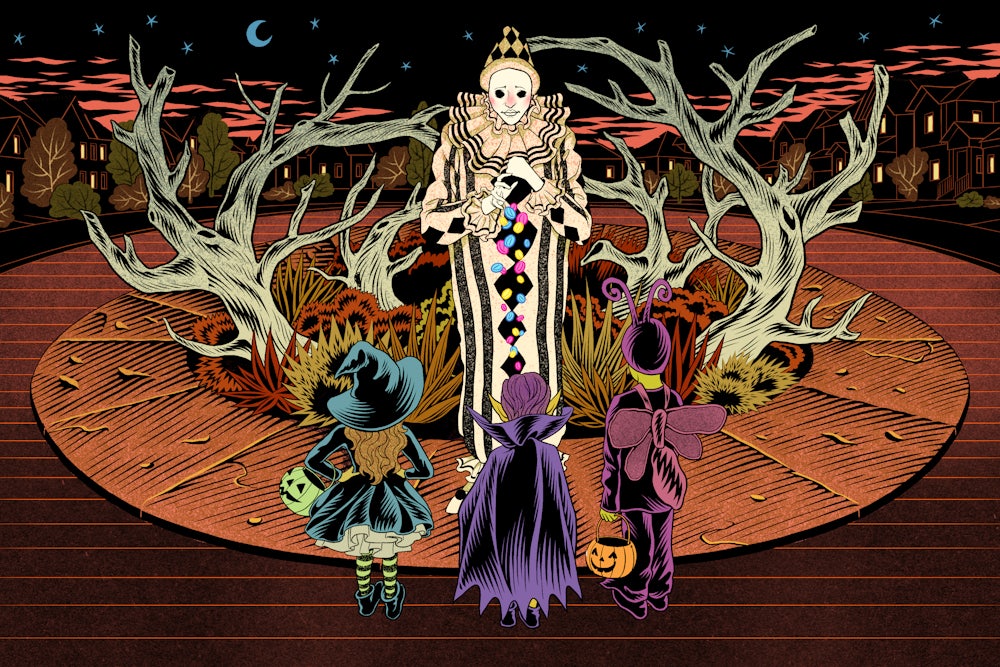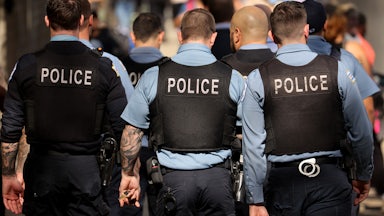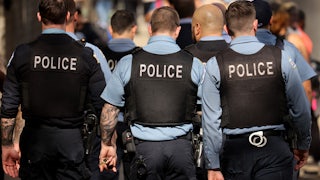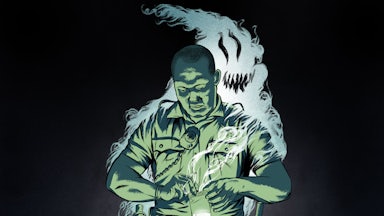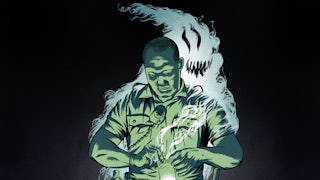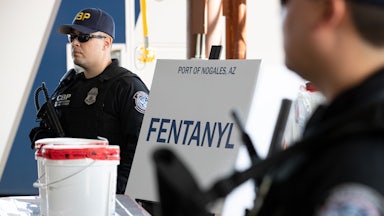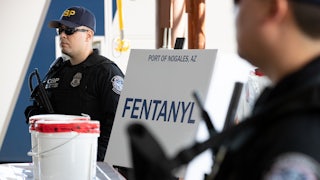Are evil-minded strangers trying to hook your kids on candy-colored fentanyl? As Halloween approaches, a dire story is making the rounds about the threat to children of so-called rainbow fentanyl. Is there anything to the Drug Enforcement Administration’s warnings? When it comes to synthetic opioids, where do the real dangers lie? On episode 55 of The Politics of Everything, hosts Laura Marsh and Alex Pareene discuss how the rainbow fentanyl panic fits into a longer history of Halloween fears. Guests include Zachary Siegel, who writes about drug policy and the criminal justice system; the sociologist Joel Best, who has studied urban legends about poisoned Halloween candy; and regular TNR contributor Natalie Shure.
Chuck Schumer [news clip]: This is a picture of real fentanyl. These are SweeTarts. And if you opened up this little container of SweeTarts, it would look about the same.
Ronna McDaniel [news clip]: Just last month, 2,000 pounds of fentanyl came across the border. That could kill 500 million people. We’re coming into Halloween. Every mom in the country right now is worried: “What if this gets into my kids’ Halloween basket?”
Lara Trump [news clip]: If one child dies from this on Halloween, I gotta tell you, we have to take action to stop this right now, because parents are terrified, and we have no answers. What are we going to do? They’re gonna go trick-or-treating.
Jeanine Pirro [news clip]: I mean, basically, parents have a decision to make: You don’t let your kids get that candy.
Alex Pareene: The days are getting shorter, the leaves are changing, the neighbors have a 12-foot skeleton in their yard, and murderous strangers are trying to kill your children. It’s October in America.
Laura Marsh: For decades, stories have spread on schoolyards, in living rooms, and on local news about poisoned Halloween treats. This year’s version of the threat, according to the Drug Enforcement Administration and politicians like Ronna McDaniel, is so-called rainbow fentanyl.
Alex: Fentanyl is a real and deadly problem, but is it more likely to end up in a trick-or-treat bucket just because it’s now candy-colored?
Laura: This week on the show, we’re asking why these scary stories about threats to innocent children come up every year. I’m Laura Marsh.
Alex: And I’m Alex Pareene.
Laura: This is The Politics of Everything.
Alex: In October, authorities seized 15,000 brightly colored fentanyl pills in a Lego box, apparently destined for distribution in New York City. The seizure came in the middle of a wave of media stories about the dangers to children of so-called rainbow fentanyl. We’re joined now by Zachary Siegel who writes about drug policy and the criminal justice system to talk about what these seizures mean. Zach, thank you for joining us today.
Zachary Siegel: Yeah, I love the show. Happy to be here.
Alex: Let’s get to the really, really basic question here. What is fentanyl, and what was seized here compared to what you might get in a hospital?
Zach: Most simply, it is a synthetic opioid, which means unlike other opioids such as morphine or heroin or oxycodone, fentanyl doesn’t require any raw organic compounds that are found in the poppy plant. All you need to manufacture fentanyl are the right chemical precursors. And then so there’s that distinction between what’s found on the street versus the hospital, and the big difference there is that in the hospital you’re getting pharmaceutical-grade, FDA-approved fentanyl. This is a legal, regulated substance, and that means people know how much to use. They know what the dose is. It’s very, very safe for sedation and surgery, but it’s also such a disaster on the street because nobody knows what they’re getting. There’s a very small window between the therapeutic dose and lethal dose.
Alex: The situation with street fentanyl—how bad is the fentanyl situation right now?
Zach: It’s pretty remarkable to see how rapidly street fentanyl has just fully penetrated America’s drug supply. It can only be measured in the metric tons. And so we’re also dealing with staggering numbers of overdose deaths, and I think that’s where things get complex because there is a genuine threat. Over 70,000 people died from drug overdoses linked to the illicit street fentanyl just last year.
Laura: So it makes sense there’s a lot of concern about fentanyl, the prevalence of fentanyl, its prevalence just on the street in all kinds of drugs that could be cut into, and you might not know, but I want to talk specifically about this rainbow fentanyl idea and break down the example that Alex mentioned. There’s a lot of different pieces to this story. First, I want to just establish what the narrative in the news is. What are people saying about the rainbow fentanyl pills, and what are they supposed to be doing?
Zach: The new “rainbow fentanyl” phenomenon comes from a DEA press release where basically they said this is a new attempt by the drug cartels to lure and entice young children as new customers to hook this younger generation of people. The whole premise was based on the fact that the pills have these kind of poppy pastel colors, that it’s pink and yellow and green and blue, and they look like Skittles or something, but not really, but that’s what they say.
Laura: So according to the the urban legend version of this slash the DEA narrative, children like candy, and if they see other stuff that vaguely looks like candy, they will want this and thus become addicted.
Alex: And then become fentanyl addicts.
Laura: The DEA has warned that traffickers might use social media to push these pills on children, and they even included a guide to emojis that drug dealers might include when they’re trying to sell ultimately rainbow fentanyl to children. I have several questions about this. One, is it that new for pills to be colored? I mean if you have any prescriptions, you’ve probably got some orange pills, some blue pills, pink, yellow. This is the way people keep track of, “This is the pill I take on Tuesday mornings; this is the pill I take on Fridays; this is the one I have two times a day.” If you know anyone who’s elderly, color-coded pills really help people keep track of all the medications they have to take.
Zach That’s absolutely right. I think there’s totally banal reasons why these are colored, very anodyne and nothing really sinister behind it. I think of Benadryl. It is neon pink. No one is accusing Benadryl of trying to target children with their product. It’s branding. We all see a bright pink pill and we associate it with Benadryl, and that’s how marketing works.
Laura: Is it new for fentanyl to come in different colors though? A year ago, would the pills all have been white? Is this actually a change in what’s going out on the street?
Zach: No, it really isn’t. For a while the fentanyl pills being seized were mostly all blue, and they were really trying to mimic and replicate a popular brand of oxycodone. The demand is for pharmaceutical pills, but those are very hard to get. These suppliers are filling that demand because they have so much fentanyl. They don’t know what to do with it, so they’re trying to sell it as counterfeit pills.
Laura: Some of the emojis that the DEA is warning against are, they include the pill emoji, which, that makes sense, fair enough, but there’s also a chocolate bar emoji, a bus emoji. Then they are claiming that the emoji code for Adderall is an “A” with a train next to it. It all seems very mysterious. I’m not sure what it means, if you have a kid who’s using—
Alex: What if your child is just an urbanist?
Laura: Or they just love transit—which lots of kids do! It seems like the phenomenon of identifying something really omnipresent and attaching it to a worrying trend. It’s easy to be like, “Oh, this is popping up at the same time as this worrying trend,” but it’s popping up because it’s just widely used.
Zach: The two DEA emoji codes that I love are, first, a cookie, which allegedly means a large batch of drugs, and then the apparent universal sign for drugs is a maple leaf, for some reason.
Alex: Really?
Zach: That’s according to the DEA’s Emoji Decoded.
Alex: Sure. Yeah.
Laura: I just like the idea that the emojis hold the key to solving this enormous problem. Like if we can just figure out what emojis people are using that will shut this whole thing down.
Alex: Well, that’s why it’s such a classic drug war story here, though. We’re talking about a story that was essentially the result of a DEA press release that tries to simplify this issue. But what you were describing is basically, the rise of fentanyl as a result of it being harder to get oxycodone, and it’s harder to get oxycodone because that was the previous drug that we waged war on—only for fentanyl to take its place.
Zach: Exactly, we’re playing whack-a-mole here. In the ’90s, it was the Kurt Cobain years and it was just plain old heroin. In the early 2000s, it was oxycodone, and we get the Purdue Pharma scandal. As soon as the FDA started to make OxyContin, which is Purdue Pharma’s oxycodone drug, more difficult to get, and they changed the formula, right around 2010, it looks like, in the Centers for Disease Control and Prevention data, a nuclear bomb of heroin overdose deaths happened because everybody switched over to the illicit supply. Then heroin had its time for only a couple years before we really started to see illicit fentanyl basically supplant the heroin market. And so that’s where we’re at now, where every drug that kind of comes along in this game is just deadlier and more potent than the last.
Alex: Just to be really clear, the drug-dealing business, it’s a business, and you don’t typically give your supply away to children—
Laura: —for free, to clarify.
Alex: One wouldn’t usually do that if one was, for example, in the business of selling drugs.
Zach: We’re all laughing because if you think about it for more than five seconds, it literally crumbles, like it falls apart, and we can’t even grab onto any substance here because it just frankly doesn’t make any sense.
Laura: I want to unpick one more piece of the example Alex gave of the fentanyl that was seized in the Lego shipment. People who are raising concerns about this would point to the fact this was found in Lego as a kind of smoking gun that suggests, “See, this really was something that was aimed at children. It came in with toys.” It’s just so perfect as a story, on cable news, on local news. So if the drugs are found in a Lego box, what does that mean?
Zach: Yeah. It means that any product that is being shipped into America, it can be used to stash some fentanyl supplier’s product. It is very hard to detect fentanyl because it is so compact, it’s so potent, it can evade the DEA and the border patrol. Instead of a big, bulky shipment of heroin, which has kind of a distinct smell to it, fentanyl is just a tiny package of white powder and enough of that can be cut and broken down to be sold in hundreds of thousands of doses depending on the weight.
Alex: That really cuts to the heart of what is so absurd about the way it’s frequently spoken about by law enforcement in the media. There’s this idea that the fact that it’s “candy colored” or that it’s found near toys is evidence of some attempt to brand fentanyl as for children, but they’re selling a product that has a demand, period. There’s marketing involved, I guess, but it’s still just selling drugs to drug users.
Zach: Exactly. And this isn’t only a phenomenon with fentanyl. MDMA, ecstasy pills, they’ve always had some brand, and it’s often like luxury brands because people in clubs might find it enjoyable that they took a Chanel pill or something. This has always been the case—there’s Mercedes logos on MDMA pills. It’s kind of the same thing.
Laura: There’s another part of the logic of this rainbow fentanyl panic that also has been puzzling me. Drug dealers are going to give children fentanyl, possibly pretending it’s candy, in order to get them hooked. That seems to be one of the fears out there in the media narrative. But at the same time, we are told that just touching fentanyl, it’s so deadly that that could be enough to kill you.
Alex: Yeah. Police officers are dropping left and right.
Laura: How do those two things fit together? How can you get someone hooked secretly by giving them fentanyl while also insisting that just being near it is so dangerous that it could even cause death?
Zach: That question really gets at the kind of irreconcilable tensions at work here. It’s hard not to look at everything happening about fentanyl, right in the run-up to the midterm election, where we have these warring sides fighting over crime, there’s civil unrest. It seems like fentanyl is this container to hold all these societal fears and anxieties.
Alex: It’s like there’s fentanyl the real drug that too many people are dying of, but then there’s fentanyl the subject, the symbol, the media story, which is almost a different beast entirely.
Zach: Exactly. That’s a really good way to put it.
Alex: Zach, thank you so much for talking to us today.
Zach: It was great. Thanks for having me on.
Laura: Read Zachary Siegel’s latest article for The New Republic, “Police Are Repeating the Drug War’s Dark History in the Fentanyl Era” at NewRepublic.com.
Alex: After the break, we’ll be back to talk about how the rainbow fentanyl panic fits into a long history of fears about poisoned treats on Halloween.
Laura: We’ve been talking about so-called rainbow fentanyl, brightly colored fentanyl pills, and the fear that drug cartels are using it to target kids, especially on Halloween. The sociologist Joel Best has been studying fears of poisoned or contaminated Halloween candy for several decades. He calls the idea that strangers are deliberately handing out dangerous substances or items like razor blades “Halloween sadism,” and he’s tried to track down cases of it actually happening. He wrote a paper on his findings in 1985, and he’s been updating that paper ever since. Joel, you’ve been studying fears about Halloween sadism since the 1980s. When did this all start?
Joel Best: Well, trick-or-treating is not as old as you think it is. Trick-or-treating really becomes widespread after the Second World War, and it’s an anti-delinquency measure. I’ve had people—people a little older than I am—tell me that they heard people would heat pennies in skillets and pour them into the outstretched hands of trick-or-treaters; that would be a story from the late ’40s or early ’50s. So almost as soon as trick-or-treating becomes widespread, it’s there.
Alex: Wow.
Laura: You described trick-or-treating as an anti-delinquency measure. What does that mean? What were they trying to stop kids doing on Halloween?
Joel: In the good old days, in the first half of the twentieth century—Halloween, there was never one way to celebrate Halloween—but Halloween was often celebrated by adolescent boys who would go out and commit acts of vandalism. The prototypical example, which isn’t very realistic today, is tipping over outhouses and doing things like that. There were people that were always complaining that this was out of control. Some communities very deliberately said, “OK, this is what we’re gonna do for Halloween. Halloween is going to be something that’s done on a particular day, at a particular hour. Children are going to walk from house to house in costumes. Householders will give them treats.” It was intended to make it more of a domestic thing. The whole family was involved. Littler kids were involved. The older kids were expected to behave themselves.
Laura: So there was this effort to make it more orderly by having trick-or-treating, but the fears of something bad happening went back to the very beginning. You started studying this in 1985. What did you find?
Joel: I looked at press coverage going back 25 years, and at that moment, it was 1958. It seemed to me that it was very unlikely that this was happening, and I figured if it was, the news would cover it. So I looked at the three biggest papers in the three biggest metro areas, The New York Times, the LA Times, and the Chicago Tribune, and I couldn’t find any evidence of any child having been killed or seriously hurt by a contaminated treat picked up in the course of trick-or-treating.
Laura: So what you see in the press is lots of stories about this, but they’re all warnings and reports of concerns being raised?
Joel: Yeah, you see very, very few stories. I’ve only found maybe 150 stories since 1958 where they specify a town and they specify how the treat was contaminated. And virtually all of these stories say, “Fortunately, nobody was hurt.” There just isn’t any evidence that this is happening. This is a folk tale. It’s a contemporary legend. Everybody’s heard this story. The National Safety Council and so on will put out lists of Halloween treats—“Make sure your kid can see through the mask, don’t have a costume your kid can trip over, and be sure and check the treats.”
Laura: What kinds of things are they warning against? What typically are people worrying about popping up in the trick-or-treat basket?
Joel: Well, I think the theory is that there could be some sort of poison or drugs or sharp objects.
Alex: I grew up with the razor-blades-in-apples story—we all kind of grew up with that. But I think some of the very few examples of this are kids doing pranks or, in one really tragic incident, a father poisoning his own child.
Joel: I think Ronald O’Bryan, who is the guy who did that, heard these stories and he thought, “Oh, there are lots of these. I will commit the perfect crime. I will poison my own child and no one will ever suspect me because there are all these maniacs out there poisoning kids.” In fact, the police actually fell for it for about two days, and then they discovered that O’Bryan had taken out a life insurance policy on his son and had purchased some poison. He was arrested, tried, convicted, and it being Texas, he was executed.
Alex: That speaks to something really interesting about the hold that these fears have on our psyche, or in our culture—we want to sort of externalize the danger to children, while I think in a lot of cases minimizing the danger that comes from the everyday or from at home.
Joel Best: Sure, yeah. Halloween is the most dangerous holiday of the year in terms of emergency room admissions for children. The reason is that we send tens of millions of kids out into the dark one night a year, and they get hit by cars and they trip over their costumes, and they stumble over the curb, and they wind up getting injured. They are not showing up in the emergency room poisoned
Laura: Do you see any changes in the way the stories are constructed over the years? Does it reflect specific things that people are scared of at that moment?
Joel Best: What happens is that it reflects recent news, usually September crime stories of one sort or another, and there are really five examples of this. In 1982, there were the Tylenol poisonings, which occurred in September, and that led to a lot of worried commentary about what would happen. In 2001, in the aftermath of 9/11, there were a number of rumors about terrorists plotting something for Halloween. In 2014, which was the first year that Colorado had legal outlets for recreational marijuana, the Denver police released a video saying that you need to be very careful because these edible candies look like regular candies, and everybody got very excited about that. A couple years ago, there was a case where there were a couple people who had died vaping with THC-infused black market canisters, and that was a big story: “THC lethal.” Then police in Pennsylvania arrested somebody. They confiscated some edible marijuana, which would not have been legal in Pennsylvania at that time so it obviously was brought in from out of state, and it was prominently labeled as “containing THC.” And those two stories were kind of coupled into a fear that there was going to be THC poisoning, which of course didn’t happen. Then this year, of course, we’ve got rainbow fentanyl.
Laura: Why do you think this idea endures? Why does it have such staying power? It just seems to circulate among people.
Joel: There are a couple things going on. One is that it’s a great story; we like to worry about vulnerable children, and it’s a vulnerable-child story. The other thing is, I think, it’s the best thing in the world that you can possibly worry about: There is somebody in your neighborhood who is so crazy they will poison little children at random, but they are so tightly wrapped they only do this one night a year. You can manage trick-or-treating, however you want to manage it: You can tell your kids they can’t go trick-or-treating; they can go to the mall; they have to go with you; you can only go to the houses of people you know; you can “trunk or treat” in the church parking lot: whatever you think you need to do to keep your kids safe. Then November 1, the family gathers around the breakfast table and you count noses and everybody’s there, and you can go, “We don’t have to worry about that for another 364 days.” It’s a great thing to be worried about.
Alex: It’s a very manageable fear.
Laura: It’s kind of the difference between things that are spooky and things that are scary. Something that’s spooky is this fear of something that isn’t really gonna happen. What’s scary is like your kid getting hit by a car when they cross the street, which really could happen and there’s nothing you can do to stop it.
Joel: Right, and the whole point of Halloween, of course, is that it’s supposed to be spooky, and most of us have stopped believing in ghosts and goblins, but we believe in criminals. So we’ve just transformed the old Halloween threat into a more modern, more plausible version that gives us a little thrill as we go around risking our lives picking up treats.
Alex: Joel Best is the author of numerous books, including Damned Lies and Statistics: Untangling Numbers From the Media, Politicians, and Activists.
Laura: Seen in light of urban legends about Halloween sadism, the story of rainbow fentanyl, as illogical as it is, makes a certain kind of sense. It channels anxieties about larger societal problems into a manageable fear with simple solutions.
Alex: But there’s another piece of this. After the break, we’ll be back to talk about how the myth of rainbow fentanyl serves politicians and the news media.
Alex: I think we’ve established at this point that international drug cartels are probably not targeting trick-or-treaters with rainbow fentanyl and that fears about candy-colored pills are part of this long tradition of myths about kids getting poisoned treats on Halloween. So given that this is basically a fantasy, why is the news so obsessed with it? We’re talking now with Natalie Shure, a regular contributor to The New Republic, about what politicians and the media get out of these kinds of stories. Natalie, hi, thank you for joining us.
Natalie Shure: Thank you so much for having me.
Alex: I remember 10 years ago, reading Jack Shafer, the longtime media critic, writing in Slate about parties where kids were putting prescription pills in bowls and trading them around. He couldn’t find any documented evidence of it either. Why do these stories persist without anyone ever actually uncovering examples of kids being targeted by these drugs?
Natalie: For one thing, I think that these stories really serve to support the paradigm of the drug war as it’s currently being waged. What we do know about people dying of fentanyl is that they are overwhelmingly people who are using fentanyl on purpose to get high, and aren’t able to dose properly because they don’t know what’s in it, and then tragically die as a result. The solutions to a problem like that are harm reduction. We know that things like needle exchange works. We know that things like overdose prevention sites, safe injection sites, work, safe supply initiatives; that is how we curb this epidemic. By pretending as if victims of the opioid epidemic are kids who are going to be unwittingly poisoned by fentanyl against their will, I think that that is a different paradigm that might start to justify more carceral solutions of the exact type that the DEA has been behind. Carceral solutions, I think, would be a lot more justified if the problem here was that people were psychotically poisoning children that they don’t know.
Alex: That’s a really important point, and we’re not trying, obviously, to downplay the scope of the fentanyl crisis and the opioid crisis in the United States, but there’s something about the idea of unwitting children as victims that I guess both seems scarier to people but also suggests, as you say, like the answer is punishment. When the actual real victims, in real life, of this crisis are not people who are being snuck drugs unsuspectingly, but people who are seeking them out. It’s a harder sell to say we should protect them than the “innocent kids.”
Natalie: And protecting those people, which is something that I absolutely think we should do, would lead us to a different set of solutions than the ones that the Drug Enforcement Agency is there to push. There is something very funny about the very agency that is behind all of these carceral measures being the ones that are slinging these stories that I very much hope they know are b.s. I think it would be almost worse if they really do think this is happening. That would suggest they’re even less effective as opposed to being cynical with propaganda.
Laura: It’s interesting because I think this focus on children being the victims of fentanyl—you’re right, it distracts from the people who really are suffering and really are at risk from this supply of drugs. But I wonder if it’s also distracting from the things that children are really at risk of. There are a lot of things that cause real harm to children in this country that we are not doing anything about, we have no intention of addressing. It seems like this story is also distracting from a lot of other things we could be talking about about the well-being of children in America.
Natalie: I think that you are right that it’s not very hard to think of things that actually are harmful to children. It’s not even hard to think of ways that the fentanyl crisis itself is harmful to children. A lot of the carceral measures that hurt people who use drugs, the primary victims of the fentanyl crisis, are also hurting their children. There are a whole lot of children whose parents are incarcerated for drug-related offenses whose lives would be better with more—materially, socially; parents who do overdose and become very disabled or die, who would have benefited from things like safe supply, needle exchanges, overdose prevention centers in their communities. Children are victims of the fentanyl crisis and the way it’s being handled. I think it would probably be a better use of one’s time to look at those things instead of imagined crises of rainbow-colored fentanyl that is trying to hook them years before they can afford to buy their own drugs.
Alex: I think that we have gotten at this point in a few different waves, but there’s something—for the U.S. psyche, for the media, for politicians—appealing about these sorts of crises that you can blame on an outsider, that you can address with punitive measures against villains, that’s more appealing than something difficult like, “Let’s solve addiction in the United States. Let’s actually address the problems that kids face for real.” There’s something almost comforting about fantasy problems facing children that are easier to address than the very real things that threaten them.
Natalie: Yeah, on a very basic level, panic about children does get eyeballs. Another much more cynical thing to point out whenever there’s Halloween panic afoot is the fact that local outlets especially are looking for Halloween content. Everyone’s got to have holiday-pegged content, and a story like this not only crosses off your holiday content box but also makes you feel like you are doing some sort of public service.
Laura: I was just looking around to see who was the first person this year that had associated the rainbow fentanyl thing, specifically, with Halloween because the DEA had their press release about rainbow fentanyl and there were warnings about that. But it seems like the origin this year of the story that the rainbow fentanyl will be in Halloween trick-or-treating just came from a couple of outlets reporting the DEA had issued this press release in the month of October. It was phrased as “ahead of Halloween,” and then there’s nothing in the story that’s related to Halloween, nothing from the DEA about Halloween that I’ve seen. It’s like, “DEA issues warning ahead of Halloween,” which literally just means it was like October 2.
Natalie: Yeah, you just get the impression that someone was at a meeting, their monthly meeting, and they said, “It’s October, let’s talk about Halloween stuff.” Someone kicked this out there, and they nodded and then handed it to their comms person.
Alex: You can’t get sued for repeating what the cops tell you or what a politician says in public. That also means you don’t need to confirm it. When the police give you material that’s free material, when you’re in the media, and it’s just sort of easy to say, “Here’s something Chuck Schumer said, here’s something the DEA said, or here’s something the local police department said.” You don’t have to do any extra expensive reporting. You can just be like, “Here’s the thing that authorities said.”
Laura: The interesting thing too about this is that it’s this rare bipartisan issue, where you have Chuck Schumer warning against this specifically, but then you also have Ronna McDaniel, the head of the Republican National Committee, saying almost exactly the same thing. It’s like the rare thing they can agree on is the issue that’s completely made up.
Alex: Yeah, the thing that will bring together the two war sides in American politics is fighting against imaginary problems.
Natalie And crime, right?
Alex: Of course. Yeah.
Natalie: Imaginary issues related to crime—you’re just going to knock it out of the park in terms of hitting your numbers, getting your constituents excited, making them feel grateful that you are looking out for them and alerting them to various community issues. I think that that is a huge problem, and I think that as much as we’ve had some willingness to reevaluate mass incarceration and certain aspects of it, I think people are surprisingly uncritical about some of the rhetorical dynamics that eventually lead to those things.
Alex: Natalie, thank you so much for joining us.
Natalie: Thank you so much for having me.
Alex: I’m just going to admit to really bad parenting here, but Julius had a terrible toothache, and we took him to the dentist, and he has a big cavity in one of his molars. It’s literally candy that has turned out to be the deadly threat to my child—but there’s no danger of fentanyl. I think with Halloween, the threat is actually the candy for me this year.
Natalie: If his toothache gets bad enough, rainbow fentanyl might be a really good solution!
Alex: Yeah, it might be. I’ll try that.
Alex: The Politics of Everything is co-produced by Talkhouse.
Laura: Emily Cooke is our executive producer.
Alex: Myron Kaplan is our audio editor.
Laura: If you enjoy The Politics of Everything and you want to support us, one thing you can do is go to wherever you listen to the podcast and rate the show. Every rating in review helps.
Alex: Thanks for listening.
